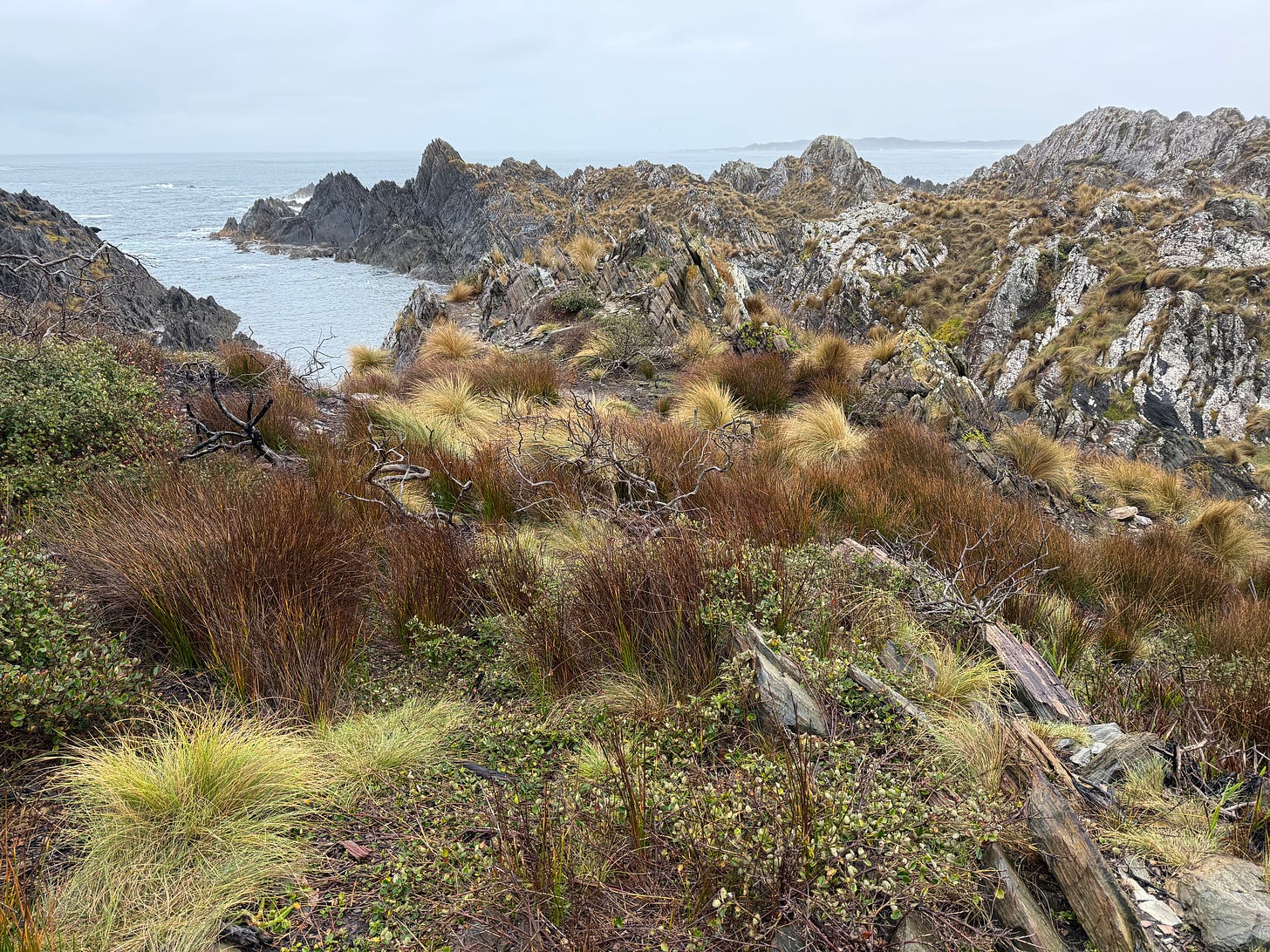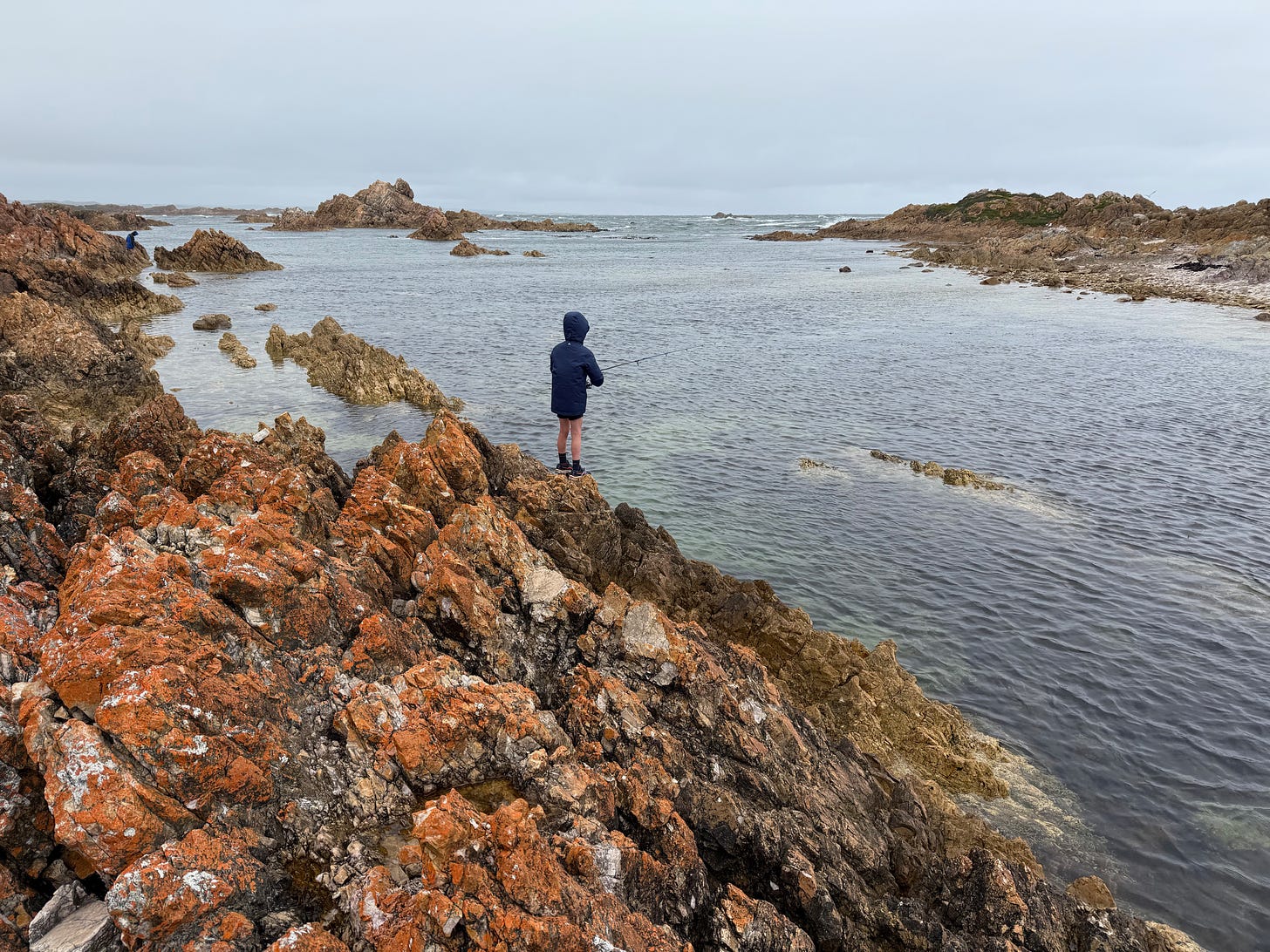When the wind blows from the east, fish bite the least
and other mysteries from a journey around northwest Tasmania
Dearest wild and wonderful readers,
We are home. Our road trip around the northwest coast of Tasmania was wonderful; filled with, in no particular order — a lamb called Leo, a rainbow of tulips, dear friends, dips in the ocean, cycling adventures, beach combing, hiding with a book, fishing, and a small hurricane of wind1.
What have you been up to?
In this edition, a story about the things that we feel but cannot see — the mysteries of our world. I hope you enjoy.
Thank you, as always, for your support. I love writing this newsletter and I am so glad that you are here.
With friendship and kindness,
Kate x
I like to call things as they are.2
Cloudy sky.
Hungry children.
Rotting seaweed.
I’m not complaining. It’s a habit, from a long tradition of watching and naming.3 You may be familiar with it? You may think, as I once did, that finding a name for something brings you closer to understanding it.
But on this October day in Arthur River, a small hamlet on the western most edge of the island of Tasmania, I am not sure what sort of day it is. I cannot find the right words.
Everything is backwards, except the River, which still flows out into the ocean and continues unbroken by landfall for 15,000 km to the tip of South America.
You see, water usually adheres to the rules of gravity. But the powerlines bend, like bows ready to launch an arrow; the trees threaten to stand up straight, after years of bowing to a wicked wind from the west; and the fish do not bite.
My eight-year-old son, Sidney, bows his head and kicks his shoes against the rocks on the edge of the River. He doesn’t have words either, just sounds, guttural and groaning. He winds his reel in tight, tucks the hook behind the line, and closes his fishing box.
You see all morning he has been been fishing and the only thing he has landed is a stick and his father’s line. I try not to laugh and for a moment I consider giving some motherly advice. But my husband frowns and shakes his head. It seems no one is in a good mood, just like the fish.
As we wander up the dunes to the shack we have rented for the week, my husband tells me the truth of the morning — No one catches a fish in easterly weather.
I throw my head back and laugh. How ridiculous! But he assures me that all of this is a well known fact, a fishing lore, observed all over the world. There is even a poem4, that rhymes neat and clean, as if the shape of the words begets belief. But I am not convinced.
How do the fish know what the wind is doing? I whip back.
My husband tries to explain, something about water turbidity and barometric pressure. But I am no longer listening, I am staring at the native shrubs shivering on the dunes — round mammalian shapes like something out of a topiary catalogue, perfect in their flora arrangement. But who could have cut them, I wonder. Surely, these creations cannot be the work of nature.
And then the wind picks up, as if in answer to my questions, howling like a small hurricane, blowing my beanie off. While high above the seabirds ride the gusts with such grace that they do not even need to flap. And I am enchanted by this invisible force. How mysterious the wind is, despite all that we have come to know, despite centuries of scientific learning.
*
Later we ride our bikes over the narrow bridge above the tea-coloured River and around the headland onto the beach. As we cross, our bikes lean dangerously inland, the wind threatening to run us into the concrete railings. Not a soul is out on the water.
Strangely, my children are energised by the weather, pumping their wheels as if ready to take off into the sky. They find a path of hardened sand at the edge of the ocean and we follow. Huge logs are littered all over the dunes — skeletons of the forest riding the rapids out to sea only to be washed ashore by the fierce swell.
We leave our bikes at the dunes and continue over the headland on foot. An ever flowing artwork of clouds travels overhead as we navigate rocks as sharp as razors, deep chasms filled with giant kelp and a myriad of molluscs. We rest at a sheltered cove on a patch of smooth grey-speckled rocks.
As we unload a picnic from our backpacks the children wander. Before long there are squeals and shouts, announcing a discovery. We hurry to look. On the ground behind us, lying in the dirt littered with sun bleached shells are flakes of rock, sharp as knives.
You see this, Mum? Arthur, my youngest son, tells me as he rubs a smooth curve on a flake as black as night. That’s for your thumb. And here, this one, feel the edge. I reach out, the stone cold and keen against my skin.
There is much excitement, for they appear to be stone tools made by the Manegin people to hunt and prepare their food, hundreds, perhaps thousands of years ago.5
And there is something else that catches our attention — four large concave circles, strange depressions like nests pressed deep into the gathering of rocks. They are big enough for two of us to sit in. We ponder their creation. My husband wonders if they are Indigenous seal hides, something he heard about when talking with a Ranger yesterday. We walk around their edges, stand with our backs to the wind, look out at the crisp curves of the swell, and imagine —
A sky awash with clouds and sea mist, women diving for shellfish, others hiding in circular depressions just above the high tide line, waiting for seal pups to swim ashore, and children, just like ours, playing on the dunes.
But we can only guess. We cannot call these things as they are because most of this knowledge has been lost, to the ravages and heartbreak of colonialism and the slip of time.6 We know so little of how the Manegin people lived here for thousands of years, while glaciers grew and retreated, and across the sea grand civilisations came and went.
Perhaps they will always remain a mystery to us — like the habits of the wind and the appetites of fish in an easterly squall. And so many other unknowable things — the mind, the depths of the ocean, the inside of black holes, and time. Cancer is like this too, but I do not need to tell you this. It moves through so many of the people that we love — a mystery of cells devouring us from the inside out. How much there is in this world that we do not understand.
But despite everything — the things that hurt us, the things we have lost and have yet to — all this unknowable mystery is perhaps one of the purest joys of being alive.
And wonder, the simplest form of happiness, don’t you think?
*
On our last day at Arthur River the wind changed. The sea hurtled towards the shore. The air clogged with mist. We rode our bikes to an archipelago just north of the River.
Sidney, opened his tackle box, tied a hook with fresh bait, and cast his line. We explored the rock pools and waited. While below the rippling surface, a fish opened its mouth and took the hook, line and sinker. And Sidney, called it what it was.
A fish, Dad, Mum, look, I caught a fish.
And we bowed our heads and laughed in astonishment.7
A poem from the edge of the world
Just south of Arthur River there is a stone plinth with a poem inscribed on it. It was written by tourism pioneer Brian Inder (1930—2019).
The Edge of the World
North West Coast Tasmania
By Brain Inder
I cast my pebble onto the shore of Eternity.
To be washed by the Ocean of Time.
It has shape, form and substance.
It is me.
One day I will be no more.
But my pebble will remain here.
On the shore of Eternity.
Mute witness for the aeons.
That today I came and stood.
At the edge of the world.
Things I have loved reading on Substack
The inner lives of astronauts by Canadian author
. A review of the Booker shortlisted novel Orbital by Samantha Harvey.Evanescene by Tasmanian author
. A little rumination of beginnings and the freedom of being invisible.A trip to the end of the road + asparagus muffins by Tasmanian author
. Join Julie as she drives to the most southern point of Tasmania, and shares the perfect road trip recipe.
Other things
I’m excited about the launch *tonight* of Alexandra Louise Harris’ novel — Violetta and the Paganini Poltergeist — the second adventure in the Violetta musical middle-grade series. There’s mystery, classical music (an ebook and album) and masks. Alexandra is a talented violinist, teacher and writer. If you are a musical family you’ll love her stories.
I missed Tasmanian author Robbie Arnott launch his new novel — Dusk — but this review is compelling.
I picked up
’s new children’s picture book — To Stir with Love at our local bookshop yesterday. It is a gorgeous tale about family and her grandma’s everything cake. I can’t wait to bake this with my children.Hilarious and uplifting family reading via — My Family and other Animals by Gerald Durrell. So many parallels to our family life. Audio and TV series just as good.
Until next time,
Wishing you a little mystery and a fish on the end of your line,
Kate xx
On Tasmania’s west coast, the Roaring Forties bring constant, strong winds and high rainfall.
This story was inspired by the poem, Calling Things What They Are, by Ada Limòn. You can read the entire poem here.
Nomenclature is the naming of things using words and language. It is perhaps, as old as humanity itself and has become more complex and systematic as human communication has evolved. The science of naming biological things is taxonomy.
Wind from the west, fish bite the best | Wind from the east, fish bite the least | Wind from the north, venture forth | Wind from the south, stay near the hearth. (Southern hemisphere variant, for the northern hemisphere switch north and south wind rhymes).
For some 40,000 years, the Tarkiner, Peternidic and Manegin clans lived in this area. Ancient middens, hut sites and other artifacts make this coastline one of the richest human archaeological zones on the planet.
Within just 40 years of European arrival, Tasmania’s Aboriginal population had been reduced from 15,000 to 40. Most having died of European diseases or killed. The surviving group was exiled to Flinders Island. You can read more here. Tasmanian Aboriginals developed complex knowledge systems that were committed to memory and passed down through generations via oral traditions. Some traditions have been passed on by survivors but much knowledge has been lost.






How amazing it must have been to come across the midden and tools, left as they were by the last hand to touch them. Magical, and heartbreaking at the same time. So many lives, so much knowledge, destroyed. Thank you for sharing that moment.
And wow about the fish!
Hi Kate. I just love reading about your family adventures. What a great gift you are giving your children, and, come to think of it, yourselves. Love the photos. What’s better than Nature, especially moving water?